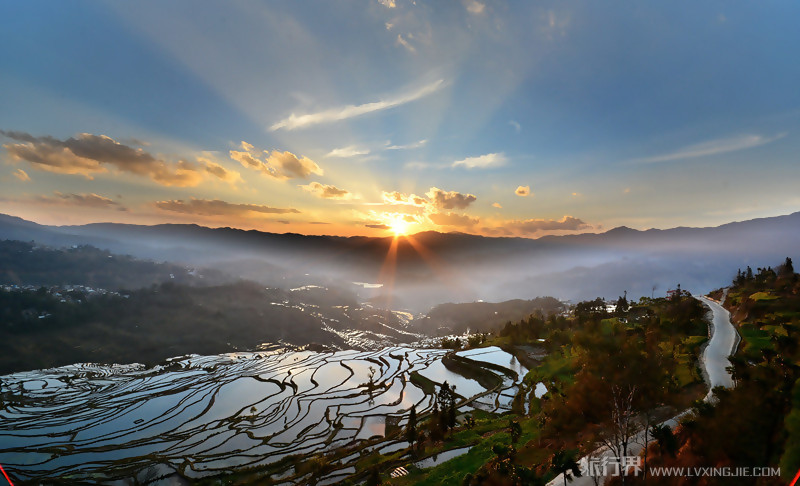

 Among the continuous stretch of Ailao Mountain, many terraces with dozens of or even over a hundred steps zigzag upwards along the slopes from the foot of the mountain, range upon range, straightly reaching the vast expanse of the cloud, which is extremely magnificent.
Among the continuous stretch of Ailao Mountain, many terraces with dozens of or even over a hundred steps zigzag upwards along the slopes from the foot of the mountain, range upon range, straightly reaching the vast expanse of the cloud, which is extremely magnificent.
Within thousands of years, facing the living space of great mountains and forges, the Hanis have created and summed up a set of rich experience of cultivating terraces. They build dykes and banks according to different kinds of topography and soils, and by making use of the national conditions of "however high a mountain is, so is the water," draw perennially flowing mountain springs into the terraces through irrigation channels and ditches. In early spring, terraces of varying shapes and sizes are filled with spring water, in the bright sunlight, generating shining ripples by mountain breezes.
The Hanis in Ailaoshan Mountain have a common saying: terrace is the face of a young man. Whether a young man is good-looking or not largely depends on how his terraces are made. If he is expert at all jobs, such as building banks, scraping dykes and ploughing fields, he will gain praise by the people and win girls' love. Also, the crucial element of whether a girl is beautiful is how she behaves in terraces.
Terrace is the important source of clothing and food for the Hani People. Therefore, they extremely treasure water. In order to do farm work in the right season, there has been a folk custom of "carving wood to ration water" since ancient times. According to the acreage a flow of spring could irrigate, people gather together and decide the amount of water every piece of field needs. Then they put up a piece of cross wood at the entrance of the field, and carve a graduation of the needed water on it. As the stream flows by the fields, the water, which is just adequate for the field, is led into the field automatically.
Every household of the Hanis breeds fish in terraces. Having transplanted seedlings of rice in March, people put the fish fry into the terraces and let them grow themselves. In the late autumn, while harvesting the rice, baskets of fresh fish also become delicious dishes on dining tables.
Buffalo is a capable assistant for cultivating terraces, and, as a result, the Hanis have a long custom of respecting buffalos. When a cow gives birth to a calf, the whole family immediately go and cut tender grass in the mountains to feed it, sometimes even adding fat meat and brown sugar syrup in. In cold days, they do not hesitate to wrap it up with old clothes and cotton fiber against coldness. On the third morning of the calf's birth, the family will present a large bowl of steamed glutinous rice before the cattle pen. In accordance with the population of the family and the number of cows and calves, they knead the rice into bowl-sized balls, one for each cattle and family members. This custom shows the equal position of man and buffalos.
You will only receive emails that you permitted upon submission and your email address will never be shared with any third parties without your express permission.
